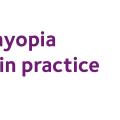

Explaining myopia management to children
It’s common for children to feel nervous when attending their first eye examinations. There are simple steps eye care professionals can take to make them feel at ease and explain the importance of myopia management

Simple changes can be made to ensure that the necessary equipment is at the right height for a child and the images within the practice and consulting room are appropriate for a child.

Beyond this, consideration should be given to the extra information needed to reassure a child with myopia during the whole process and how to manage the treatment plan going forward.
Your action plan for successful myopia management
As well as ensuring you have the necessary equipment to practice myopia management, it is just as important to feel prepared and confident in your communication to your patients.
Created in harmony with the UK’s optometry leaders, you can download our free action plan for step-by-step advice on how to offer myopia management in practice.
Why do the experts recommend myopia management?
Hear why leading optometrists and ophthalmologists believe offering myopia management should be a duty of care for patients.
Managing children in practice*
-

Low Risk Child
>+0.75DS at age 6 or younger1
- Monitor as required
- Advise parents to limit close work outside of school hours
- Encourage two hours of outdoor time per day2
-

At Risk Child
≤+0.75DS at age 6 or younger1
- Monitor frequently
- Watch out for large myopic changes over a short space of time e.g.+1.25DS to +0.50DS in 6 months
- Advise parents to limit close work outside of school hours
- Encourage two hours of outdoor time per day2
-

Myopia Confirmed
- Provide supporting information
- Prescribe glasses with full correction
- Discuss all myopia management options
- Follow up within 2 weeks and book myopia management contact lens assessment
- Advise parents to limit close work outside of school hours
- Encourage two hours of outdoor time per day2
*Evidence-based recommended approach to managing children in practice
Discover MiSight® 1 day contact lenses with ActivControl™ technology
Download our Myopia management resources
-
CLEERE Study Group Early Childhood Refractive Error and Parental History of Myopia as Predictors of Myopia. Invest Ophthalmol Vis Sci. 2010 Jan; 51(1): 115–121.
-
Rose KA, Morgan IG, Ip J, et al. Outdoor Activity Reduces the Prevalence of Myopia in Children. Ophthalmology 2008; 115:1279-1285.








